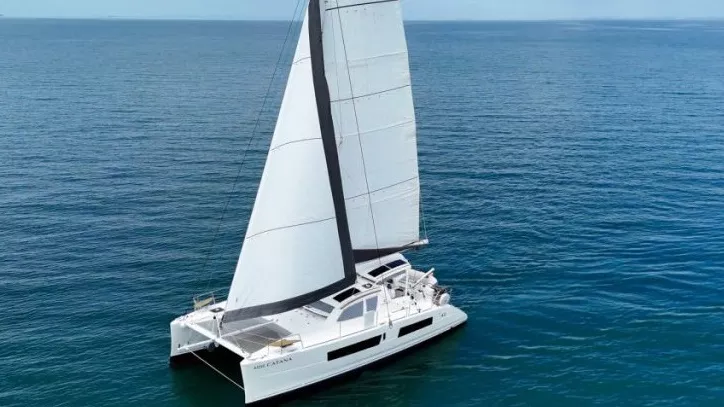Embarking on a solo sailing journey requires careful selection of a catamaran that offers stability, ease of handling, and comfort. Catamarans, with their twin-hull design, provide enhanced stability and ample space, making them ideal for single-handed sailors. In this expanded guide, we delve deeper into six top catamarans suitable for solo sailing, highlighting their unique features and considerations.
6 Best Solo Sailing Catamarans
1. Leopard 39/40 (circa 2010)
The Leopard 39/40, built by Robertson and Caine, is celebrated for its user-friendly design tailored for solo sailors.
Key Features:
- Helm Station Design: Features a walkthrough helm station with all lines led aft, allowing the skipper to manage sails and helm simultaneously.
- Rigging: Equipped with a fractional sloop rig, it simplifies sail handling, making it ideal for solo sailors.
- Cockpit Layout: The spacious cockpit provides easy access to controls, enhancing safety and convenience during single-handed operations.
Considerations:
- Size and Maneuverability: Its compact size ensures ease of handling, but it’s essential to assess docking and storage facilities.
- Performance: While designed for comfort, some sailors may desire more responsive sailing characteristics.
2. Lagoon 39/40/42 (2015 and newer)
Lagoon’s 39, 40, and 42 models are designed with solo sailors in mind, incorporating features that facilitate easy handling.
Key Features:
- Self-Tending Jib: The design includes a self-tending jib, reducing the need for constant adjustment and making tacking simpler.
- Aft-Mounted Mast: Positioning the mast further aft allows for better balance and easier management of the mainsail and jib.
- Cockpit Design: The cockpit is designed to allow the skipper to perform all necessary tasks without leaving the helm, enhancing safety and ease of operation.
Considerations:
- Cockpit Space: While spacious, it’s important to ensure that the cockpit layout aligns with personal preferences for single-handed operations.
- Sailing Performance: Some sailors may prefer a more performance-oriented design, as Lagoon emphasizes comfort.
3. Prout Snowgoose (circa 1987)
The Prout Snowgoose is an older model that remains a favorite among solo sailors due to its manageable size and thoughtful design.
Key Features:
- Double Headsail Configuration: Equipped with two headsails on furlers, providing versatile sail options for various wind conditions.
- Aft-Mounted Mast: The mast is located near the helm, allowing the skipper to handle reefing and hoisting without leaving the cockpit.
- Maneuverability: Its design offers excellent maneuverability, making it suitable for single-handed docking and anchoring.
Considerations:
- Age of the Vessel: Being a model from 1987, potential buyers should assess the condition of the boat and be prepared for maintenance.
- Performance: While stable, some sailors may find its performance less responsive compared to newer designs.
4. Dolphin 42
The Dolphin 42, crafted in Brazil, is recognized for its stability and ease of handling, making it a solid choice for solo sailors.
Key Features:
- Daggerboards: Incorporates daggerboards for enhanced stability and the ability to point higher into the wind.
- Lightweight Construction: Built with a foam core, it offers reduced weight and improved performance.
- Comfortable Amenities: Features amenities such as hot water, air conditioning, and a refrigerator, ensuring comfort during long voyages.
Considerations:
- Draft: The daggerboards may require deeper water, limiting access to shallow anchorages.
- Handling: While stable, solo sailors should familiarize themselves with the handling characteristics, especially in varying wind conditions.
5. Manta 42
The Manta 42, produced in Florida during the late 1990s to 2000s, is celebrated for its lightweight design and ease of handling.
Key Features:
- Lightweight Build: Its relatively light construction makes it responsive and easier to manage under various sailing conditions.
- Structural Design: Features pinned aluminum crossbeams that absorb twisting forces, enhancing durability and performance.
- Customization Potential: The design allows for the addition of features like solar panels or dinghies without significantly affecting performance.
Considerations:
- Space Utilization: Solo sailors should assess the layout to ensure it meets their comfort and storage needs.
- Performance vs. Comfort: The Manta 42 balances performance with comfort, but sailors seeking high-performance racing may consider other options.
6. Freedom 36
The Freedom 36 is a distinctive catboat rigged with a large mainsail, offering simplicity and ease of handling for solo sailors.
Key Features:
- Un-Stayed Mast: Equipped with a free-standing, un-stayed mast, eliminating the need for traditional rigging and simplifying sail management.
- Self-Tending Jib: Includes a small, self-tending jib, providing additional power when needed without complicating operations.
- Simplified Sailing: The rigging system allows for straightforward sail handling, making it ideal for single-handed cruising.
Considerations:
- Performance: While easy to handle, some sailors may find its performance less dynamic compared to other catamarans.
- Space and Amenities: Solo sailors should evaluate the interior space and amenities to ensure they align with their cruising requirements.
Additional Considerations for Solo Sailing Catamarans
When selecting a catamaran for solo sailing, it’s essential to consider factors such as size, sail plan, helm accessibility, and safety features. Modern technological advancements, such as electric winches and powered sail controls, have made single-handed sailing more accessible, even on larger vessels.
Additional Considerations:
- Technological Enhancements: Incorporating modern sailing technologies can significantly ease the demands of solo sailing. Features like electric winches, powered sail controls, and advanced autopilots can assist in managing sails and navigation with minimal physical strain.
- Safety Measures: Prioritize safety by equipping the catamaran with reliable autopilots, man-overboard systems, and easy-to-deploy life-saving equipment. Regular drills and familiarization with the vessel’s systems are crucial for handling emergencies alone.
- Training and Experience: While catamarans offer stability, solo sailors should possess a solid understanding of sailing dynamics, weather patterns, and emergency procedures. Gaining experience through courses and practice can build confidence and competence.
Incorporating these considerations into your selection process will help ensure a rewarding and safe solo sailing experience.

